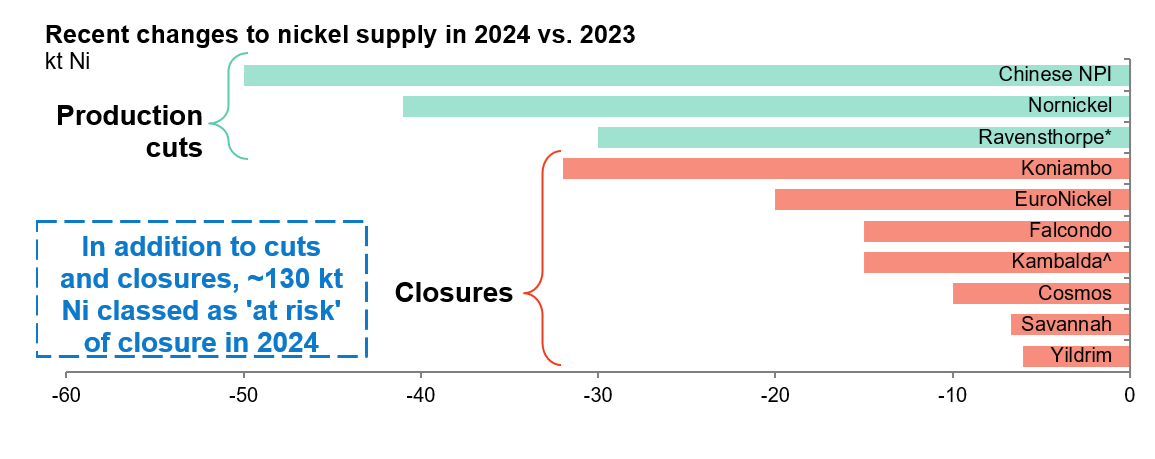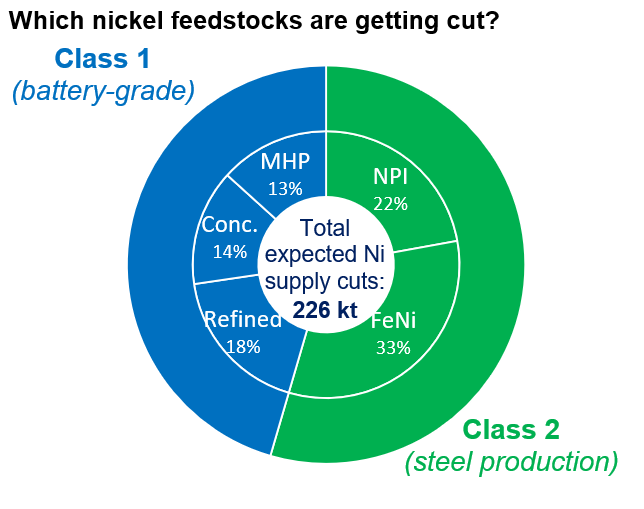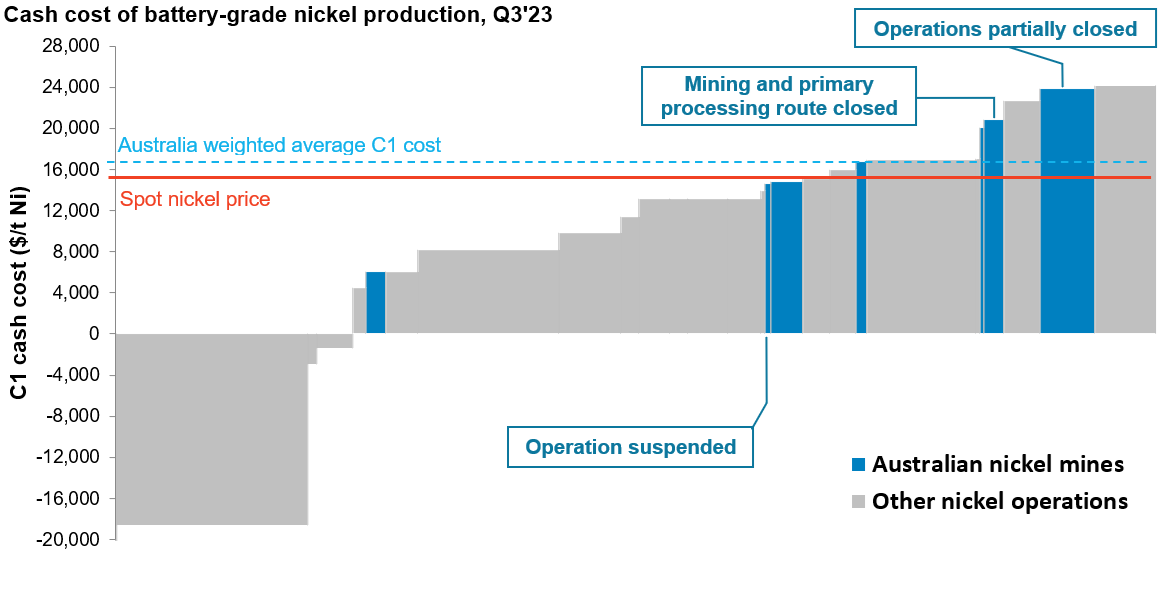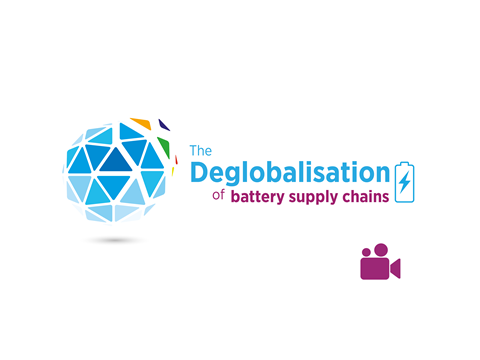Will the nickel market stay unbalanced?
Nickel production cuts are underway
7 February 2024
At least six nickel mines are expected to stop production
Nickel supply cuts announced since our last forecast (Q4’23) are expected to reduce the nickel market surplus by at least one-third to ~330 kt this year, excluding projects. This remnant oversupply is expected to keep the nickel prices and producer margins under pressure for the next 24 months, before beginning to recover.
The nickel price has caught up with higher-cost producers, leading to production cutbacks
-
According to SFA (Oxford)’s estimates, global nickel supply (excluding Indonesia) could see closures equal to ~225 kt in 2024, equal to 6% of 2023 mine supply. For context, Indonesia could add >300 kt of new production in 2024 alone if projects under construction reach commissioning. Below shows SFA’s latest nickel supply updates from production cuts and closures. Expected nickel supply cuts and closures come from:
-
Falling nickel prices in 2023 rapidly eroded nickel mining margins in Australia (Ravensthorpe, Cosmos mine, Savannah mine and BHP’s Kambalda concentrator). As of Q3’23, most are estimated to be cash-flow negative. Since SFA’s last quarterly supply forecast, Australia’s expected nickel production for 2024 has fallen by 19% to 165 kt and is now expected to be flat year-on-year.
-
In Russia, Nornickel released its 2023 production and 2024 guidance figures last week. Nickel production guidance is 17-22% below initial forecasts for this year at 184-194 kt. The expected reduction is a result of delayed smelter maintenance, and not cost-related.
-
SFA forecast Chinese NPI production to fall by 50 kt this year to 250 kt. Domestically produced NPI is being substituted for newer, lower-cost supply from Indonesia in Chinese steel mills. Our data partner Shanghai Metals Market reports that utilisation rates at Chinese NPI smelters have been in decline since 2019 and are now at the lowest point since mid-2017 at ~40%.
-
In addition, SFA also expect temporary closures from ferronickel operations in 2024 at EuroNickel (N. Macedonia), Falcondo (Dominican Republic), and Yildrim (Serbia).
Production cuts and closures from Class 1 and Class 2 nickel

Source: SFA (Oxford). *loss of MHP production. Some nickel concentrate production remains. ^BHP’s Kambalda concentrator was primarily fed by ore from Wyloo Metals.

Source: SFA (Oxford)
Current planned closures increase market share of ‘dirty’ nickel
-
Australian nickel miners market their metal as ‘green’, as opposed to ‘dirty’ nickel from Indonesia where operations commonly use standalone coal power plants and extraction of nickel ore requires significant deforestation. Closures and production curtailments seen year-to-date reduces the pool of available ‘green’ and non-Chinese-controlled nickel for end-users.
-
Nornickel produces nickel with the lowest carbon footprint per tonne of metal, and is one of the largest single producers of refined nickel. The lower production forecast and greater market share of Indonesian nickel will raise the global average emissions per tonne of nickel produced.
Excess supply is in Class 2, whereas most cuts are from mines that produce battery-grade nickel
-
Excess NPI supply from Indonesia is where the fat lies for the nickel market. Class 1 metal stocks are still relatively lean, though LME stocks have begun to trend higher in recent months.
-
Class 2 production is where cuts are really needed to balance the market. Currently announced production reductions will be insufficient to offset the forecast market surplus.
-
It’s possible some Indonesian NPI capacity will be idled during 2024 . Though lower input costs (ore) and the integration of Indonesian NPI into Chinese supply chains is likely to make this production stickier than other geographies in the current downcycle.
-
Of the 132 kt nickel production at risk of closure this year, ~60% is in FeNi and nickel hydroxide cake from the New Caledonian nickel processing operations still operating. At present they are classed as ‘at risk’ and remain in SFA’s base case, though the risk is elevated following the closure of Glencore-backed Koniambo this week. The fact that no agreement could be made with the French government for this operation highlights the acute funding issues being experienced. Eramet have withdrawn funding for the island’s ferronickel operations, and Trafigura won’t contribute additional financing to the Goro mine and processing plant.
Australian nickel mines were the first to take action but others could close
-
In January, abundant nickel supply from Indonesia and global mining cost increases have pressured profit margins for Australian nickel mines, leading to closures; major battery-grade nickel producers in Australia are exploring cost-cutting options while producers are also facing pressure.

SFA (Oxford) estimates, company reports.
About us
SFA (Oxford) regularly updates its nickel supply, demand and price forecasts using its propriety databases. If you would like to find out more about SFA’s battery metals research and consulting services, please contact Daniel Croft or Beresford Clarke for a complimentary call.


Upcoming events
Join us 9 May in Oxford as we delve into cutting-edge insights, innovations, and discussions led by the foremost authorities including SQM, CATL, and MINI at SFA (Oxford)'s Battery Metals Lectures 2024.

Brought to you by

Daniel Croft
Commodity Analyst

How can we help you?
SFA (Oxford) provides bespoke, independent intelligence on the strategic metal markets, specifically tailored to your needs. To find out more about what we can offer you, please contact us.
